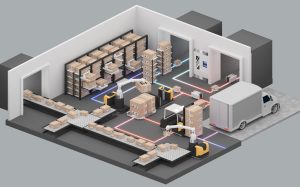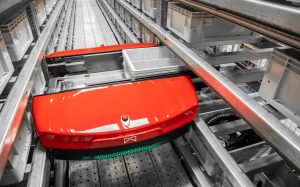7 Practical Tips for Pharmaceutical Warehouse Layout Optimization in 2024
As pharmaceutical warehouse managers, we understand that pharmaceutical warehouse layout optimization is the key to unlocking the full potential of storage and logistics capabilities.
Want to supercharge your operation’s efficiency? Optimize your warehouse for a logistics edge that cuts costs and boosts customer satisfaction.
From cold chain mastery to automated excellence, the right tweaks can make your supply chain a powerhouse. Ready to upgrade your game? Let’s optimize!

(Copyright image from “https://www.freepik.com/free-photo/view-full-warehouse-with-forklift_17244024.htm#fromView=search&page=1&position=3&uuid=968a425f-e4ff-445a-97de-f8338233b97b”>Image by wirestock</a> on Freepik)
▲Principles of Warehouse Layout Optimization
☑Overall Integration
A well-integrated warehouse layout ensures that various elements, systems, and processes of the operation—from humans to robots, from receiving to shipping, from raw materials to finished products—all work in harmony. This integration facilitates smooth transitions between different stages of the supply chain, minimizing delays and enhancing efficiency.
☑Space Utilization
Maximizing the use of available space is crucial in warehouse management. Effective space utilization can reduce the need for additional storage facilities and lower real estate costs, all while improving operations.
☑Flow Optimization
Ensuring a smooth flow of goods is essential for reducing bottlenecks and increasing throughput. A well-designed layout should facilitate the natural progression of products from entry to exit points.
☑Flexibility
Being able to adapt to changes in demand, new technologies, and market conditions is vital for long-term success. A flexible warehouse layout can be easily reconfigured to meet evolving business needs.
▲Navigating the Path of Warehouse Layout Optimization
1. Maximize Vertical Storage
Making the most of vertical space can significantly increase storage capacity without expanding the warehouse footprint. High-density racking systems and multi-tiered racking are excellent ways to achieve this.
2. Utilize Space-Saving Techniques Like Double-Deep Racking
Double-deep racking allows for more inventory to be stored in the same floor space, effectively doubling the storage density. This technique can be a game-changer for warehouses with limited space.
3. Enhance Inventory Segregation and Consolidation
By segregating and consolidating inventory based on factors like product type, turnover rate, and storage requirements, warehouses can improve organization and efficiency.
4. Adopt Automated Storage and Retrieval Systems (AS/RS)
AS/RS, such as those provided by HWArobotics, can revolutionize warehouse operations by automating the storage and retrieval process, leading to increased accuracy, reduced labor costs, and improved space utilization.
5. Implement Warehouse Management Systems
Investing in advanced warehouse management systems (WMS) can optimize inventory management and picking routes, providing real-time visibility and control over warehouse operations.
6. Design with Modular Components to Enhance Flexibility
Modular design elements allow for easy reconfiguration of the warehouse layout without costly renovations. This flexibility is crucial for staying ahead of the ever-changing pharmaceutical landscape.
7. Set Cross-Docking Areas
Cross-docking can streamline operations by allowing products to be transferred directly from receiving to shipping areas without being stored, reducing handling and increasing efficiency.

▲Cautions while Implementing Warehouse Layout Optimization
1. Gradual Implementation
Rushing through changes can lead to operational disruptions, downtime, and economic loss. A phased and incremental approach to implementation allows for adjustments and refinements along the way.
Rank proposed changes based on their potential impact, cost, and ease of implementation. And break down the optimization process into manageable phases with a specific focus on warehouse layout. Create a roadmap for implementation and process monitoring.
2. Staff Training and Communication
Ensuring that your team is well-trained and informed about the changes is essential for a smooth transition. Effective communication can mitigate resistance and foster a positive work environment.
3. Pilot Testing
Before rolling out changes on a large scale, pilot testing can help identify potential issues and work out the kinks in the new layout. By testing new ideas, processes, or systems on a small scale, you can also reduce the risk and minimize possible loss.
4. Monitoring and Evaluation
Continuous monitoring and regular evaluations of the new layout’s performance are crucial for identifying areas of improvement and ensuring that the optimization goals are met.
Some common KPIs that could be used to measure include:
▷inventory turnover rate
▷order fulfillment time
▷space utilization
▷accuracy rates
▷cost per unit
Collect data on the current performance of your warehouse against these KPIs before making any changes.
Collect data routinely for analysis. This will help you find ways to continuously improve the warehouse layout.
▲HWArobotics’ Solution for Warehouse Layout Optimization
HWArobotics offers a comprehensive warehouse layout optimization solution featuring automation and intelligent systems.
Our offerings are engineered to enhance efficiency, productivity, and adaptability, making them an excellent choice for businesses looking to future-proof their warehousing operations.Tote Shuttle Robot System (Mini LoadASRS For Vertical Storage
⒈ The Tote Shuttle Robot Systems by HWArobotics include:
▷SLS300 Series –Tote-handling AS/RS Shuttle Robot System for efficient standardized size product processing
▷SLS400 Series– Variable Tote-handling AS/RS Shuttle Robot with dynamic adjustment capability
▷SLS500 Series– Tote-handling AS/RS Shuttle Robot that supports FIFO operations
▷SLS600 Series — Tote-handling AS/RS Shuttle Robotsupport multi-directional movement and integrated inventory management
These systems excel with features and functions like modular design, space utilization, operational efficiency, and inventory management, particularly for businesses dealing with small-sized items or components.

⒉ Pallet Shuttle Robot System (HeavyLoadASRS For Vertical Storage)
In addition to tote shuttle systems, HWArobotics also offers four-directional pallet shuttle systems.
①FPSS1500A
②FPSS1500B
They are designed for efficient handling and storage of pallets. These systems are suitable for room-temperature and low-temperature environments, respectively, and are equipped with European-series parts for quality and reliability.
Conclusion
With a commitment to innovation and reliability, HWArobotics is the partner you need for smart and efficient warehouse layout optimization solutions.
Don’t miss out on the opportunity to enhance your warehouse operations with HWArobotics’ cutting-edge technology. Contact HWArobotics today to discuss your specific needs and explore how their products can drive your business forward!







